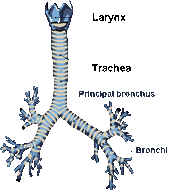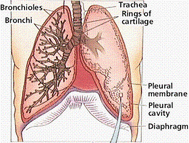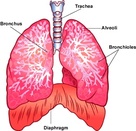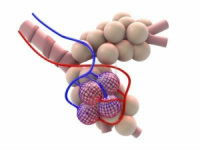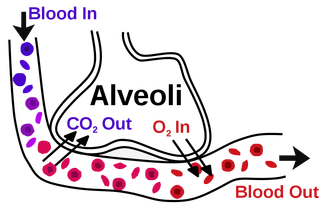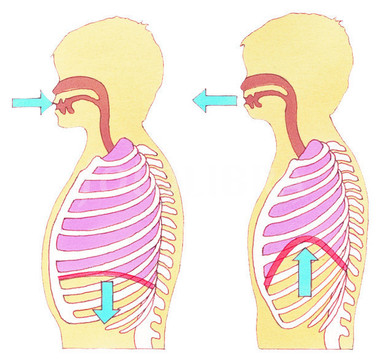Breathing
Breathing or respiration is the process where oxygen is taken and put into the blood stream. This process is to help the bodies cells
Gaseous Exchange
The gaseous exchange occurs in the lungs alveoli. It is the exchange of carbon dioxide and oxygen within the blood stream. The process begins when air is taken through to the alveoli's air sacks. When blood passes through the capillaries, a protein known as haemoglobin uses its four points to pick up the oxygen which has diffused from the alveoli to the capillaries. Any carbon dioxide in the blood stream at that time will diffuse into the alveoli so it can be taken back out. This process occurs continuously. The diagram illustrated above shows how this process occurs.
Usually a mammal has a certain time it can take before it needs to breathe again. The platypus however, is different. It's higher level of myoglobin located in its muscle tissue's allow the platypus to hold its breath for a longer period of time. This higher concentration of myoglobin is common for many marine animals.
Usually a mammal has a certain time it can take before it needs to breathe again. The platypus however, is different. It's higher level of myoglobin located in its muscle tissue's allow the platypus to hold its breath for a longer period of time. This higher concentration of myoglobin is common for many marine animals.
Respiration
Breathing:
The ventilation process is what helps to provide the air and oxygen to all the muscles and organs. The inhalation of gases such as air is an important process in the respiratory system. The diagram above shows the diaphragms movement while inhaling and exhaling. During inhalation, air travels down the trachea and into the lungs. As the lungs fill up with air, the diaphragm and intercostal muscles (located between the ribs) push down to allow more room for the air. The process for exhalation is only slightly different. When the body needs to get rid of carbon dioxide, the diaphragm contracts back up to force the gases back out. This air comes back through the trachea and out the mouth or nose.
The ventilation process is what helps to provide the air and oxygen to all the muscles and organs. The inhalation of gases such as air is an important process in the respiratory system. The diagram above shows the diaphragms movement while inhaling and exhaling. During inhalation, air travels down the trachea and into the lungs. As the lungs fill up with air, the diaphragm and intercostal muscles (located between the ribs) push down to allow more room for the air. The process for exhalation is only slightly different. When the body needs to get rid of carbon dioxide, the diaphragm contracts back up to force the gases back out. This air comes back through the trachea and out the mouth or nose.
Aerobic Respiration:
Aerobic Respiration, also known as respiration is the process that helps get oxygen from the air into the body. Aerobic respiration occurs in every living cell and helps to provide energy for the different muscles. Unlike anaerobic respiration, aerobic does not include a build up of lactic acid. Aerobic respiration uses glucose and oxygen as its reactants.
Anaerobic Respiration:
When we breathe normally, we are using aerobic respiration so when hard exercise becomes too much, anaerobic respiration kicks in. Anaerobic respiration is the build up of lactic acid which also causes cramps. Cramps is the cause of too much anaerobic respiration. When the lactic acid becomes too much, the muscles become sore or stop working.To be able to reduce cramps or stop anaerobic respiration, more oxygen is needed (this is why you still feel exhausted after a huge amount of exercise. The extra oxygen used is called oxygen debt.
The word equation for anaerobic respiration is:
Glucose ---> Lactic acid + Energy
Anaerobic exercise is short and sharp bursts of energy. Anaerobic respiration is also used for when an extra amount of energy is needed. Glucose id ideal because it can only broken down into certain parts.
Aerobic Respiration, also known as respiration is the process that helps get oxygen from the air into the body. Aerobic respiration occurs in every living cell and helps to provide energy for the different muscles. Unlike anaerobic respiration, aerobic does not include a build up of lactic acid. Aerobic respiration uses glucose and oxygen as its reactants.
Anaerobic Respiration:
When we breathe normally, we are using aerobic respiration so when hard exercise becomes too much, anaerobic respiration kicks in. Anaerobic respiration is the build up of lactic acid which also causes cramps. Cramps is the cause of too much anaerobic respiration. When the lactic acid becomes too much, the muscles become sore or stop working.To be able to reduce cramps or stop anaerobic respiration, more oxygen is needed (this is why you still feel exhausted after a huge amount of exercise. The extra oxygen used is called oxygen debt.
The word equation for anaerobic respiration is:
Glucose ---> Lactic acid + Energy
Anaerobic exercise is short and sharp bursts of energy. Anaerobic respiration is also used for when an extra amount of energy is needed. Glucose id ideal because it can only broken down into certain parts.
